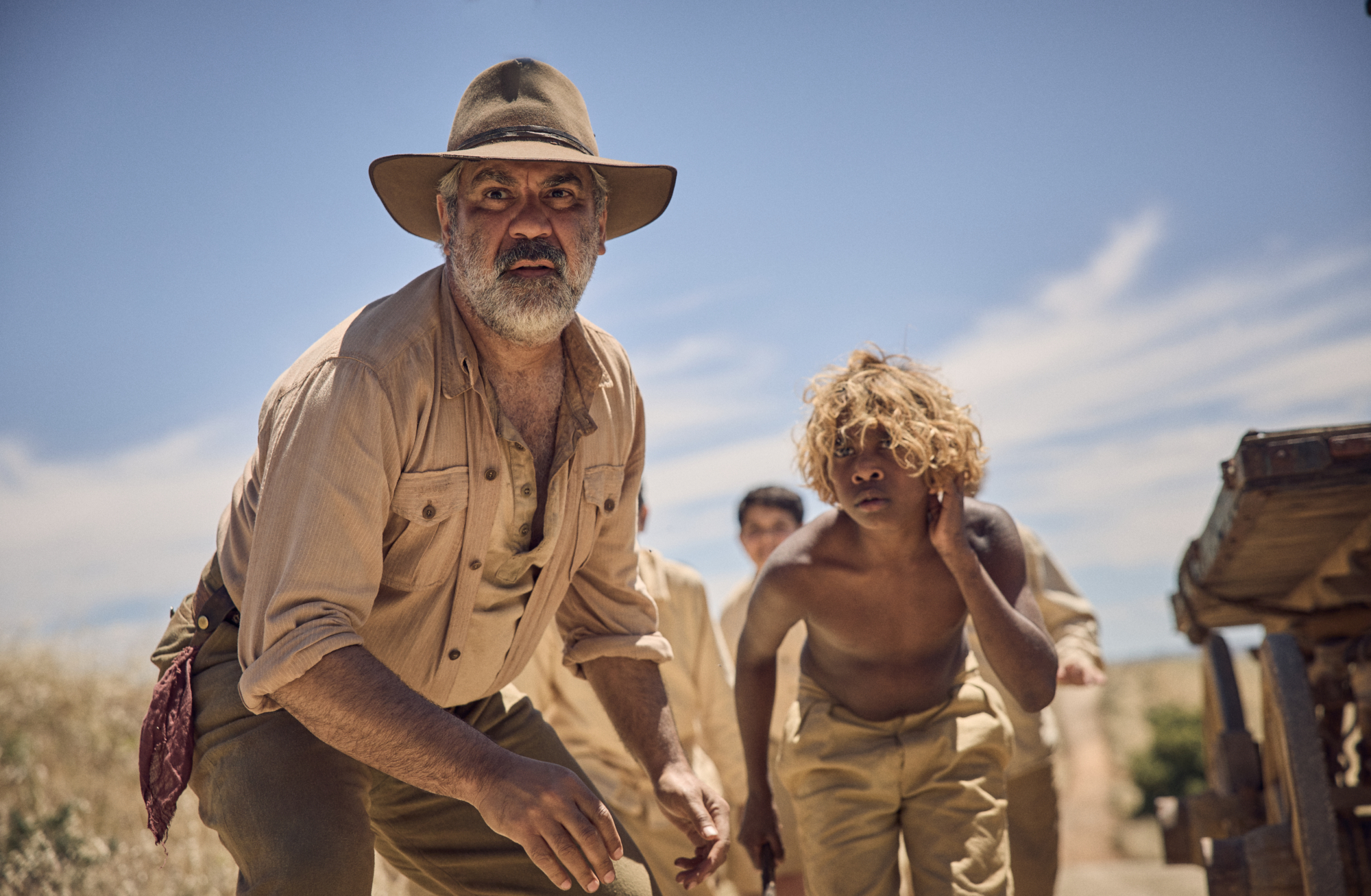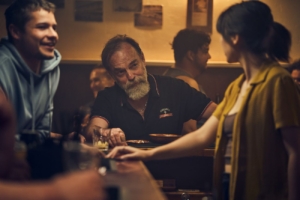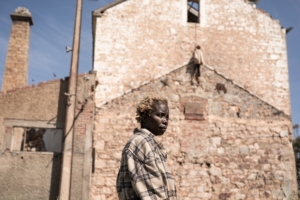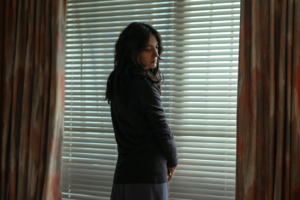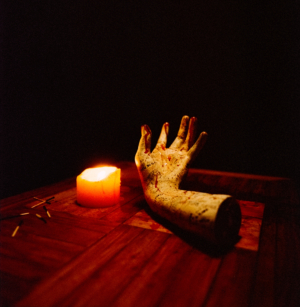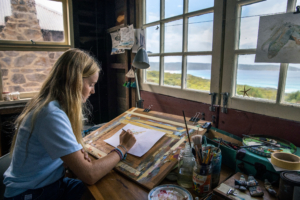‘You could get a good old thick doctorate out of this movie if you wanted to,’ says 53-year-old Kaytetye filmmaker Warwick Thornton of his latest narrative feature, The New Boy (2023). ‘References to Christianity or spirituality – it’s rife with it!’[1]Warwick Thornton, in ‘Warwick Thornton on The New Boy’, Primal Screen, Triple R, 3 July 2023. available at <https://www.rrr.org.au/on-demand/segments/primal-screen-warwick-thornton-on-the-new-boy>, accessed 14 December 2023.
Well, either a doctorate or a 2000-word essay. With its monastic setting, visual array of religious iconography, absence of dialogue and open-ended approach to storytelling, The New Boy is a film courting interpretation, just waiting for viewers – or, indeed, Melbourne-based critics – to fill in the abundant subtext lingering in its exploration of spirituality in the Australian heartland.
Its premise is simple: in early 1940s Australia, the titular New Boy (Aswan Reid) – who otherwise goes unnamed – is forcibly taken to an orphanage in remote, rural Australia, where First Nations children are taught table manners and the ways of Christianity before being sent out to work as farm labourers once they hit adolescence.
This premise might seem to suggest a study of the Stolen Generations, and thus a strident successor to Thornton’s previous fiction film, the brutal revisionist western Sweet Country (2017).[2]See Nicholas Godfrey, ‘Bad Blood and Bitterness: Colonisation and the Western in Warwick Thornton’s Sweet Country’, Metro, no. 195, 2018, pp. 6–11, available at <https://metromagazine.com.au/bad-blood-and-bitterness/>, accessed 14 December 2023. But The New Boy turns out to be a far more reserved – even open-hearted – depiction of the collision, and intersection, of different faiths, as the young Aboriginal boy and the orphanage’s leader, Sister Eileen (Cate Blanchett), seek to understand one another and embrace the power of the spiritual other.
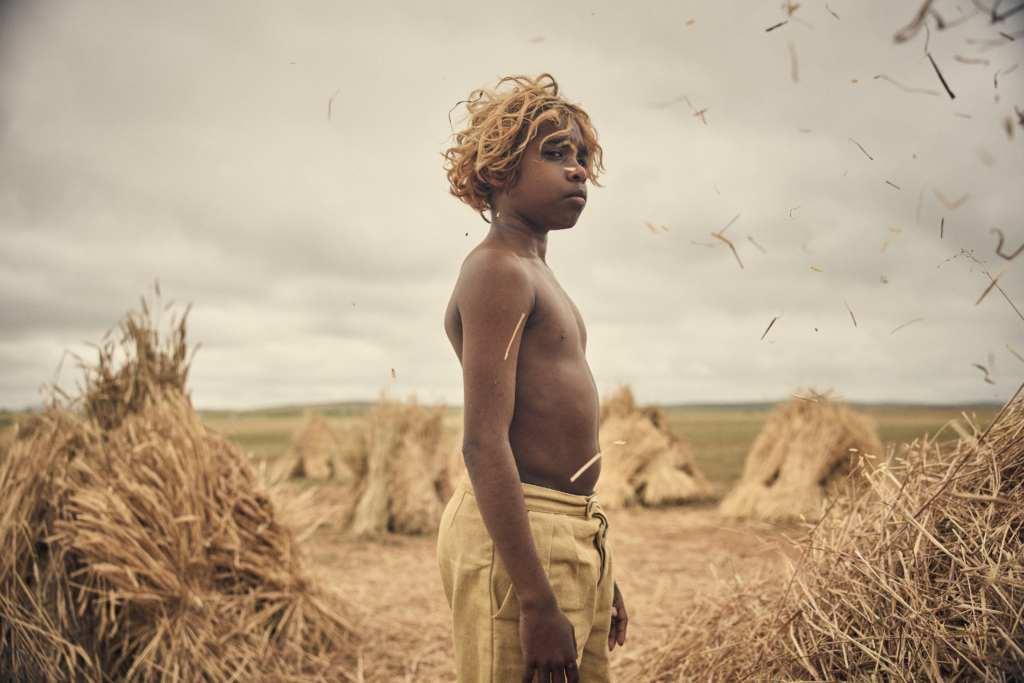
‘Aboriginal [spirituality] seems to clash with Christianity, but they can actually gel really well,’ Thornton offered, way back in 2014.[3]Warwick Thornton, quoted in Stephanie Bunbury, ‘Warwick Thornton in Conversation with God’, The Sydney Morning Herald, 1 September 2014, <https://www.smh.com.au/entertainment/movies/warwick-thornton-in-conversation-with-god-20140901-10au9t.html>, accessed 13 December 2023. But the genesis of The New Boy dates back even earlier: not just to the script Thornton started writing in the mid 2000s[4]See ‘About the Production’, New Boy Productions Pty Ltd, Create NSW & Screen Australia, The New Boy press kit, 2023, p. 6. – before he’d even conceived of his breakout debut feature Samson and Delilah (2009) – but to his own personal history. When he was eleven, Thornton was sent from his home in Alice Springs – where he’d been tending towards juvenile delinquency[5]See Patrick Brzeski, ‘The New Boy: Cate Blanchett and Warwick Thornton on Tackling the Big Questions’, The Hollywood Reporter, 16 May 2023, <https://www.hollywoodreporter.com/movies/movie-features/cannes-cate-blanchett-interview-warwick-thornton-the-new-boy-1235492595/>, accessed 13 December 2023. – to Salvado College, a ‘missionary style’[6]Warwick Thornton, ‘Director’s Statement’, in The New Boy press kit, op. cit., p. 5. boarding school situated at the Benedictine Monastery of New Norcia in Western Australia’s Wheatbelt. Though it’s a historical site long intertwined with the Stolen Generations,[7]See Sarah Collard & Lorena Allam, ‘Hundreds of Aboriginal Children Likely Buried in Unmarked Graves at Three WA Missions’, The Guardian, 10 September 2023, <https://www.theguardian.com/australia-news/2023/sep/10/aboriginal-children-buried-wa-missions-moore-river-carrolup-new-norcia>, accessed 14 December 2023. in interviews Thornton describes his experiences there as being positive, if initially confronting and overwhelming.
‘I had never been inside a church before. I walked into the church building for the first time and saw this guy being tortured on a big wooden cross and it freaked me out,’ Thornton recounts.[8]Thornton, ‘Director’s Statement’, op. cit. When he calls the church ‘the first cinema of horror’,[9]Warwick Thornton, quoted in Stephen A Russell, ‘Warwick Thornton Talks Cate Blanchett and the “Pure Cinema” of The New Boy’, Flicks.com.au, 6 July 2023, <https://www.flicks.com.au/features/warwick-thornton-talks-cate-blanchett-and-the-pure-cinema-of-the-new-boy/>, accessed 13 December 2023. he’s talking about its oft-gruesome iconography and storytelling onus towards fearmongering. ‘If you don’t pray, if you don’t believe, you will burn,’ he paraphrases. ‘For kids who haven’t been immersed in that since birth, you know, that’s pretty hardcore.’[10]Warwick Thornton, quoted in Stephanie Bunbury, ‘Cate Blanchett on Faith, Work and Being the Only Woman in the Room’, The Sydney Morning Herald, 27 June 2023, <https://www.smh.com.au/culture/movies/cate-blanchett-on-faith-work-and-being-the-only-woman-in-the-room-20230626-p5djf1.html>, accessed 13 December 2023.
Thornton set out writing the script out of a desire ‘to look more deeply at religions’.[11]Warwick Thornton, quoted in Brzeski, op. cit. But after receiving feedback that it was a ‘bit of a shit script’ – which, in hindsight, he agrees with – he stuck it in a sock drawer, only to excavate it years later when he was talking with Blanchett about collaborating on a project during 2020’s ongoing COVID lockdowns.[12]Thornton, in ‘Warwick Thornton on The New Boy’, op. cit.

The decision to change the character in charge of the orphanage from a priest – as was originally written in the script – into a nun was transformative for The New Boy. ‘By changing the gender and making her a nun, you sort of flick the environment and everything is more up for grabs in a way,’ Blanchett has said.[13]Thornton, quoted in Brzeski, op. cit. Rather than inhabiting a straightforward power dynamic, Sister Eileen and the New Boy are portrayed as two characters trying to survive in a white man’s world, finding agency where they can. Each shares a mutual inquisitiveness about the other’s faith, and about the mysticism it contains.
A striking, wordless opening, in which Thornton expertly employs sound (Nick Cave and Warren Ellis’ swelling score; location audio; Foley) and vision (slow-motion widescreen images; a POV shot from inside a hessian sack; a stream train rising up from the horizon like a whale breaching in the sea), shows the New Boy fighting with a white officer in the desert and trying to flee, before being taken down by a boomerang thrown by a uniformed Aboriginal man, put in a sack and transported overland.
Rather than inhabiting a straightforward power dynamic, Sister Eileen and the New Boy are portrayed as two characters trying to survive in a white man’s world, finding agency where they can. Each shares a mutual inquisitiveness about the other’s faith, and about the mysticism it contains.
He arrives at the unnamed monastery – the film’s principal location – in the dead of night, dropped on the doorstep by an officer who declares: ‘I’ve got a special delivery […] It’s a little darkie.’ To the spooky sound of a gramophone needle caught in a record’s lead-out groove, Sister Eileen tenderly invites the New Boy in, then carries him to the sleeping quarters housing the many other ‘orphans’ living there.
The monastery is supposed to be under the provision of Don Peter, an absent father-figure who, we soon learn, has died, though Sister Eileen has elected to maintain the ruse that he’s still alive (usually through written correspondence, but also in one memorable moment via performance). She’s covertly creating a space where those usually in servitude are given their own dominion, the only figures of ‘authority’ being her and two Aboriginal caretakers, the duly maternal Sister Mum (Deborah Mailman) and handyman George (Wayne Blair). During her rebellion – which includes drinking to an increasing degree – Sister Eileen is also in the midst of a crisis of faith, searching for answers to her existential questions and finding them in the figure of the New Boy.
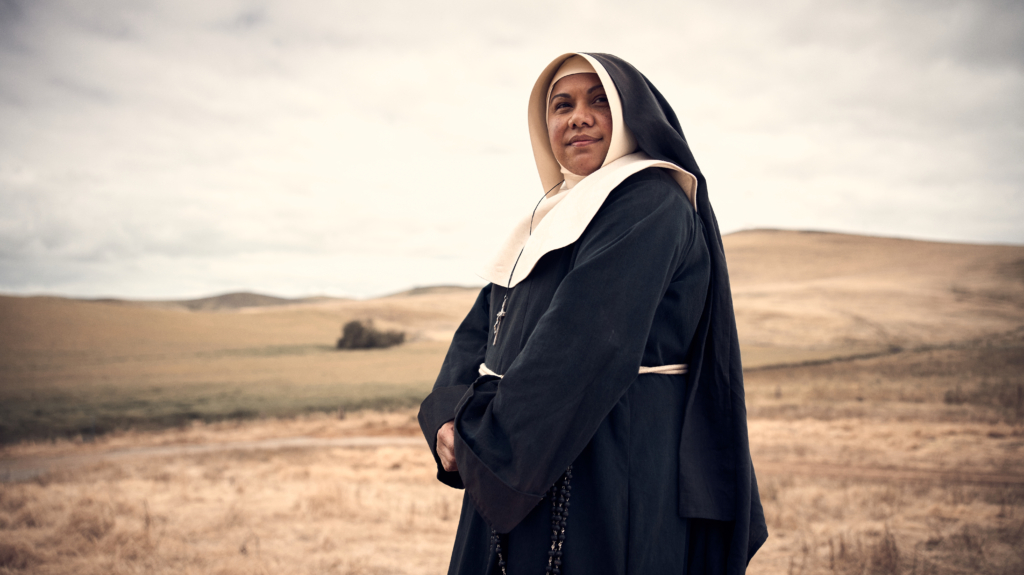
In this dramatic set-up, Thornton is upending the familiar tropes of villainous nuns or cruel missionaries, and dodging entry-level stereotypes of good vs evil (instead, he says, it’s about ‘bad people being good and good people being bad’[14]Thornton, in ‘Warwick Thornton on The New Boy’, op. cit.). The initial script that he wrote was far angrier; but by the time The New Boy was being made, he’d lived much more life, gained more perspective. ‘I like to think it was written by a child and directed by a grumpy old man,’ Thornton says, memorably.[15]Warwick Thornton, quoted in Andy Hazel, ‘Director Warwick Thornton’, The Saturday Paper, 24 June 2023, <https://www.thesaturdaypaper.com.au/culture/film/2023/06/24/director-warwick-thornton>, accessed 13 December 2023. At first, he admits, he ‘didn’t understand what it was [he] was wanting to say’,[16]ibid. but it soon became apparent that The New Boy was primarily about survival. All of the film’s key characters – the titular protagonist, Sister Eileen, Sister Mum, George, its ensemble of children – are just trying to get by; in Thornton’s view, even ‘Jesus is trying to survive, in a way’.[17]Thornton, in ‘Warwick Thornton on The New Boy’, op. cit. In portraying differing believers learning to coexist, the director says he’s making a symbolic story for a multicultural, secular nation struggling to fight off divisions and find harmony: ‘[The script is] looking at Australia and who we are, and rebalancing that to say that we’re all trying to survive.’[18]Warwick Thornton, in ‘Cate Blanchett, Warwick Thornton on The New Boy and the “Incredible Opportunity’ of the Voice | 7.30’, YouTube, 6 July 2023, <https://www.youtube.com/watch?v=Kcin8zK0r7c>, accessed 18 December 2023.
Survival is, of course, a deep notion for a First Nations storyteller. ‘I’m Aboriginal – every day is survival for us,’ Thornton has said. ‘Successions of governments have been trying to get rid of us for a very long time […] So unpacking survival, and learning, and trying to work out what the fuck just happened […] It’s what I do.’[19]Warwick Thornton, quoted in Sarah Ward, ‘Digging Up a Script for Cate Blanchett and Finding the Next David Gulpilil: Warwick Thornton Chats The New Boy’, Concrete Playground, 7 July 2023, <https://concreteplayground.com/brisbane/arts-entertainment/warwick-thornton-interview-the-new-boy>, accessed 18 December 2023.
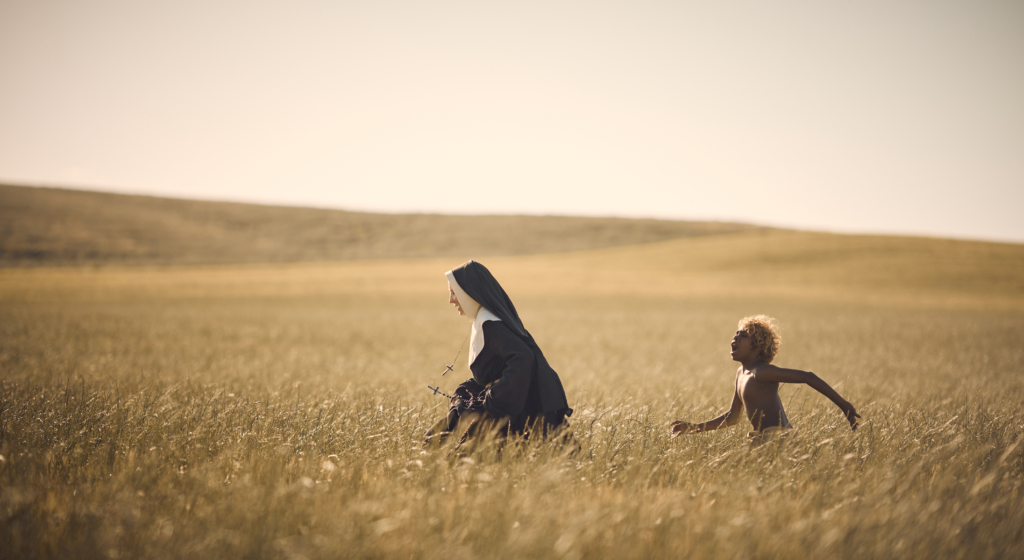
When first introduced, the New Boy is portrayed as a ‘wild’ figure in the monastery: barefoot and shirtless, eating with his hands, wandering off during church services or lessons. This figure, Thornton says, is a stand-in for ‘what happened to [First Nations people]’;[20]ibid. subjected to colonisers’ demands of religious conversion and at first suspicious of, then attracted to, Christianity, the New Boy ultimately finds his own form of spirituality, his own agency among the white man’s demands.
There’s minimal verbal communication in the film, which is both an artistic and practical choice; Thornton thought it wiser not to burden a cast filled with non-professional child actors (aged nine to thirteen) with lots of dialogue.[21]‘Warwick Thornton on The New Boy’, op. cit. The New Boy is, instead, a grandly visual work: Thornton, who began his career as a cinematographer, openly namechecks Days of Heaven (Terrence Malick, 1978), memorably lensed by Néstor Almendros, as an influence for the film’s look.[22]Russell, op. cit. Accordingly, the shooting location, outside the South Australian town of Burra, was chosen for its vistas; the monastery was then constructed from scratch, with production designer Amy Baker taking a meticulous approach to arranging its interiors.[23]‘About the Production’, op. cit., p. 9.
Reid, too, was cast in the titular role in part for his appearance, his bleached hair evoking, Thornton suggests, ‘the manmade disaster which is the Australian Wheatbelt’.[24]Thornton, quoted in Russell, op. cit. Against a backdrop of golden-hour landscapes, he stalks through the endless fields of grain, catching mice, lizards and snakes; the last of these a loaded symbol that suggests the genesis myths of both Christianity and Aboriginal spirituality.[25]For more on the role of the snake in Aboriginal belief systems, see Shino Konishi, ‘Friday Essay: Creation, Destruction and Appropriation – the Powerful Symbolism of the Rainbow Serpent’, The Conversation, 29 October 2021, <https://theconversation.com/friday-essay-creation-destruction-and-appropriation-the-powerful-symbolism-of-the-rainbow-serpent-169934>, accessed 18 December 2023.
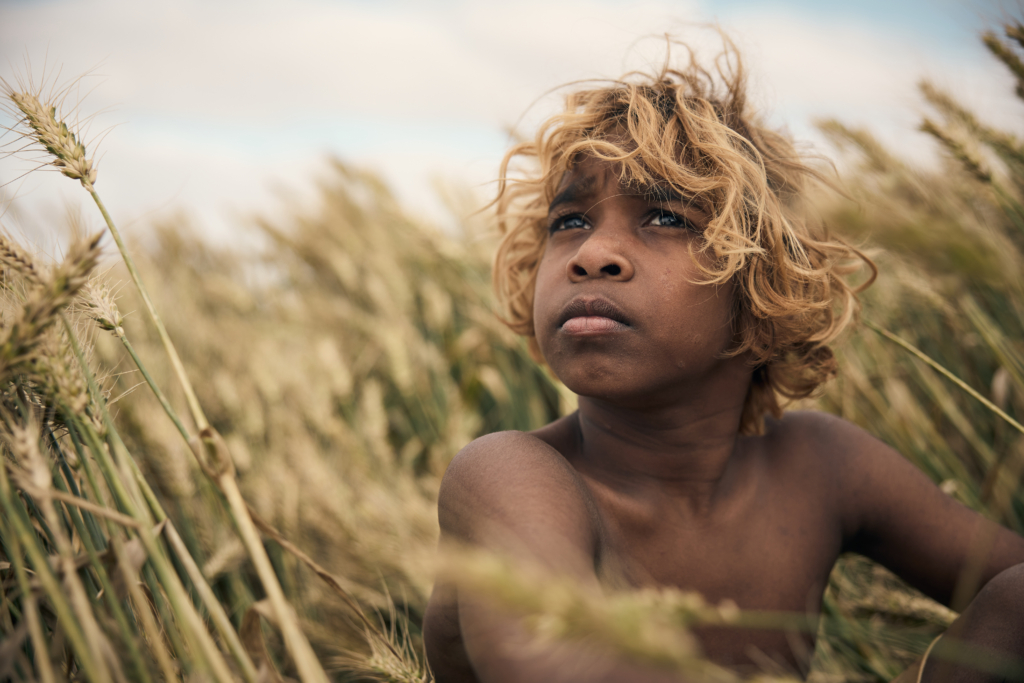
The transformative moment for the New Boy – and for The New Boy itself – occurs with the arrival to the monastery of a carving of Christ on the cross, which, in the midst of World War II, has been transported from somewhere in Europe in order to save it from falling into the hands of the Nazis (whom the orphanage’s kids call, with seemingly sincere confusion, ‘the Nasties’). The New Boy is drawn to the figure on the cross – not as a saviour, but as someone to be saved.
From early in the film, we’ve seen the New Boy’s healing powers, visually manifesting as him playing with glowing light that emanates from his fingertips. It’s a familiar visual for a superhero-saturated cinematic age; but, for Thornton, it taps into something ancient: the figure of the central Australian traditional healer, or ngangkari, which he portrayed in the 2015 video art work The Way of the Ngangkari. Just as the New Boy heals a classmate who has been hurt fighting a bushfire of biblical proportions, he also tries to help Christ: removing the nails from the statue’s feet, taking him down from the cross, bandaging his wounds, dressing him in clothes.
From early in the film, we’ve seen the New Boy’s healing powers, visually manifesting as him playing with glowing light that emanates from his fingertips. It’s a familiar visual for a superhero-saturated cinematic age; but, for Thornton, it taps into something ancient.
In one of this symbol-filled film’s most symbolic moments, the New Boy begins experiencing stigmata, as if he has taken on Christ’s pain, or their respective spiritual powers have cross-pollinated. ‘Imagine that a ngangkari met Jesus, and imagine what their conversation would be like,’ Thornton says.[26]Thornton, quoted in Brzeski, op. cit. In The New Boy, however, this conversation is wholly unspoken – perhaps, unspeakable.
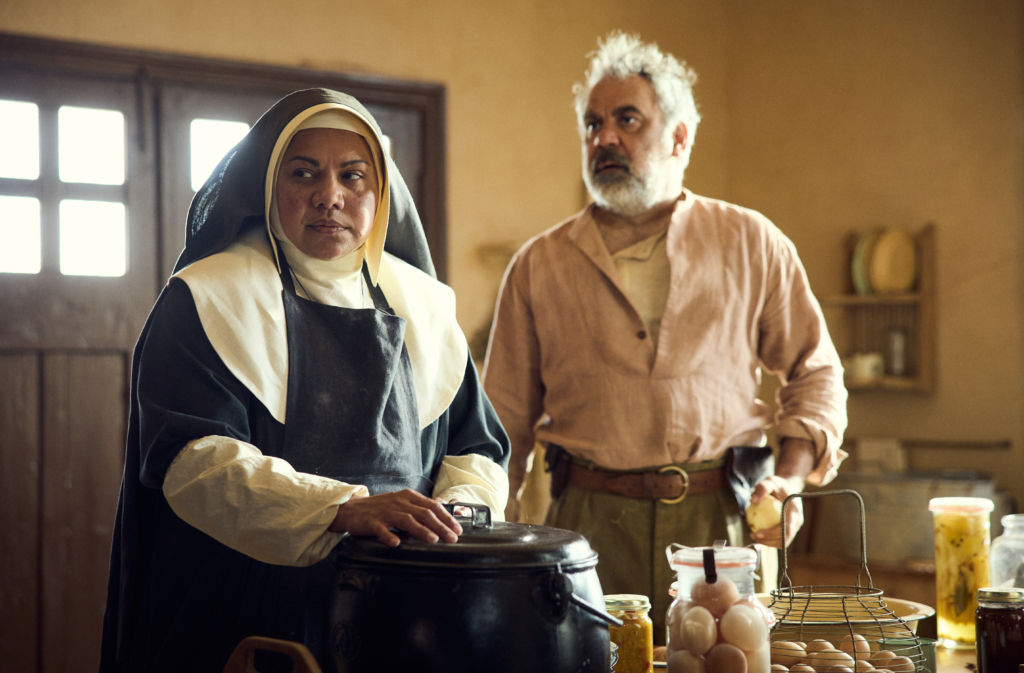
For Sister Eileen, the appearance of the stigmata is miraculous (‘She thinks, in a way: is this a black Christ?’ Blanchett says[27]Cate Blanchett, quoted in Michael Sun, ‘Cate Blanchett and Warwick Thornton on The New Boy: “Saviour Is Such a Dangerous Word”’, The Guardian, 5 July 2023, <https://www.theguardian.com/film/2023/jul/05/cate-blanchett-and-warwick-thornton-on-the-new-boy-saviour-is-such-a-dangerous-word>, accessed 19 December 2023.), and it assuages so much of her growing doubt. Having previously held off, she arranges the New Boy’s baptism and christening, giving him the name Francis. The effects of this, however, prove deleterious: now officially inducted into Christianity – his hair combed, wearing a shirt and sandals – the New Boy loses his healing powers, the white light he once harnessed flying off. This metamorphosis plays as a tragedy, a symbolic portrait of the horrors of colonisation and, in Thornton’s view, a representation of a fundamental aspect of First Nations experience: ‘Your lore, your culture and everything has just been completely obliterated […] You have to adapt in this new world that is like a plague, like a virus that has completely taken over your life.’[28]Thornton, quoted in Brzeski, op. cit.
The filmmaker shows this obliteration happening quickly, over a post-climax series of scenes that can feel weirdly abrupt: the end of the war; the kids dancing to the brassy big band standard ‘Sing, Sing, Sing (with a Swing)’; a montage showing the New Boy now a part of the community, playing among the other kids. Two final images capture The New Boy’s motif of survival, as well as its argument in favour of the coexistence of competing cultures and faiths: the film’s young protagonist picking up a snake and keeping it in his pocket; and Jesus back up on the cross, no longer suffering but, seemingly, watching over him.
It’s a finale that offers a mixture of acceptance, grief and a faint, flickering sense of hope – or, at least, that’s at least how it played to me. Rather than authoring something explicit or didactic, Thornton has deliberately left his film open-ended, refusing to define right or wrong, good or bad, black or white. ‘You want your film to ask questions,’ he explains, ‘and you want an audience, because of their own journey through life, to come to their own answers.’[29]ibid.
Endnotes
| 1 | Warwick Thornton, in ‘Warwick Thornton on The New Boy’, Primal Screen, Triple R, 3 July 2023. available at <https://www.rrr.org.au/on-demand/segments/primal-screen-warwick-thornton-on-the-new-boy>, accessed 14 December 2023. |
|---|---|
| 2 | See Nicholas Godfrey, ‘Bad Blood and Bitterness: Colonisation and the Western in Warwick Thornton’s Sweet Country’, Metro, no. 195, 2018, pp. 6–11, available at <https://metromagazine.com.au/bad-blood-and-bitterness/>, accessed 14 December 2023. |
| 3 | Warwick Thornton, quoted in Stephanie Bunbury, ‘Warwick Thornton in Conversation with God’, The Sydney Morning Herald, 1 September 2014, <https://www.smh.com.au/entertainment/movies/warwick-thornton-in-conversation-with-god-20140901-10au9t.html>, accessed 13 December 2023. |
| 4 | See ‘About the Production’, New Boy Productions Pty Ltd, Create NSW & Screen Australia, The New Boy press kit, 2023, p. 6. |
| 5 | See Patrick Brzeski, ‘The New Boy: Cate Blanchett and Warwick Thornton on Tackling the Big Questions’, The Hollywood Reporter, 16 May 2023, <https://www.hollywoodreporter.com/movies/movie-features/cannes-cate-blanchett-interview-warwick-thornton-the-new-boy-1235492595/>, accessed 13 December 2023. |
| 6 | Warwick Thornton, ‘Director’s Statement’, in The New Boy press kit, op. cit., p. 5. |
| 7 | See Sarah Collard & Lorena Allam, ‘Hundreds of Aboriginal Children Likely Buried in Unmarked Graves at Three WA Missions’, The Guardian, 10 September 2023, <https://www.theguardian.com/australia-news/2023/sep/10/aboriginal-children-buried-wa-missions-moore-river-carrolup-new-norcia>, accessed 14 December 2023. |
| 8 | Thornton, ‘Director’s Statement’, op. cit. |
| 9 | Warwick Thornton, quoted in Stephen A Russell, ‘Warwick Thornton Talks Cate Blanchett and the “Pure Cinema” of The New Boy’, Flicks.com.au, 6 July 2023, <https://www.flicks.com.au/features/warwick-thornton-talks-cate-blanchett-and-the-pure-cinema-of-the-new-boy/>, accessed 13 December 2023. |
| 10 | Warwick Thornton, quoted in Stephanie Bunbury, ‘Cate Blanchett on Faith, Work and Being the Only Woman in the Room’, The Sydney Morning Herald, 27 June 2023, <https://www.smh.com.au/culture/movies/cate-blanchett-on-faith-work-and-being-the-only-woman-in-the-room-20230626-p5djf1.html>, accessed 13 December 2023. |
| 11 | Warwick Thornton, quoted in Brzeski, op. cit. |
| 12 | Thornton, in ‘Warwick Thornton on The New Boy’, op. cit. |
| 13 | Thornton, quoted in Brzeski, op. cit. |
| 14 | Thornton, in ‘Warwick Thornton on The New Boy’, op. cit. |
| 15 | Warwick Thornton, quoted in Andy Hazel, ‘Director Warwick Thornton’, The Saturday Paper, 24 June 2023, <https://www.thesaturdaypaper.com.au/culture/film/2023/06/24/director-warwick-thornton>, accessed 13 December 2023. |
| 16 | ibid. |
| 17 | Thornton, in ‘Warwick Thornton on The New Boy’, op. cit. |
| 18 | Warwick Thornton, in ‘Cate Blanchett, Warwick Thornton on The New Boy and the “Incredible Opportunity’ of the Voice | 7.30’, YouTube, 6 July 2023, <https://www.youtube.com/watch?v=Kcin8zK0r7c>, accessed 18 December 2023. |
| 19 | Warwick Thornton, quoted in Sarah Ward, ‘Digging Up a Script for Cate Blanchett and Finding the Next David Gulpilil: Warwick Thornton Chats The New Boy’, Concrete Playground, 7 July 2023, <https://concreteplayground.com/brisbane/arts-entertainment/warwick-thornton-interview-the-new-boy>, accessed 18 December 2023. |
| 20 | ibid. |
| 21 | ‘Warwick Thornton on The New Boy’, op. cit. |
| 22 | Russell, op. cit. |
| 23 | ‘About the Production’, op. cit., p. 9. |
| 24 | Thornton, quoted in Russell, op. cit. |
| 25 | For more on the role of the snake in Aboriginal belief systems, see Shino Konishi, ‘Friday Essay: Creation, Destruction and Appropriation – the Powerful Symbolism of the Rainbow Serpent’, The Conversation, 29 October 2021, <https://theconversation.com/friday-essay-creation-destruction-and-appropriation-the-powerful-symbolism-of-the-rainbow-serpent-169934>, accessed 18 December 2023. |
| 26 | Thornton, quoted in Brzeski, op. cit. |
| 27 | Cate Blanchett, quoted in Michael Sun, ‘Cate Blanchett and Warwick Thornton on The New Boy: “Saviour Is Such a Dangerous Word”’, The Guardian, 5 July 2023, <https://www.theguardian.com/film/2023/jul/05/cate-blanchett-and-warwick-thornton-on-the-new-boy-saviour-is-such-a-dangerous-word>, accessed 19 December 2023. |
| 28 | Thornton, quoted in Brzeski, op. cit. |
| 29 | ibid. |
